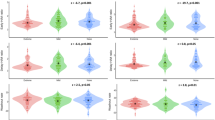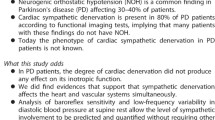Abstract
This report extends previous investigations of endogenous catecholamine levels in patients with orthostatic hypotension due to familial dysautonomia (FD), to define better the neurochemical phenotype and elucidate possible pathophysiological mechanisms. Ten FD patients (age 26.1±2.6 (SEM) years) and eight control subjects (age 29.5±3.7 years) were studied. Heart rate, blood pressure and venous blood samples were obtained while supine and after 5 min in the upright position. Plasma levels of dihydroxyphenylalanine (DOPA), noradrenaline (NA), adrenaline (A), dopamine (DA), dihydroxyphenylglycol (DHPG) and dihydroxyphenylacetic acid (DOPAC) were measured. When supine, the FD group had greater NA and DOPA levels, and lower DHPG levels. Plasma NA did not increase with erect posture in FD patients. Individual FD mean blood pressures were correlated positively with plasma NA levels when supine and with plasma DA and DOPAC when upright. In FD, DOPA:DHPG ratios were above the range found in normal subjects or that reported in patients with acquired forms of dysautonomia regardless of posture, whereas DOPAC:DHPG ratios remained normal. Thus FD patients have a characteristic neurochemical pattern which probably reflects either decreased vesicular storage of catecholamines or limited oxidative deamination despite normal or increased tyrosine hydroxylation.
Similar content being viewed by others
References
Polinsky RJ, Kopin IJ, Ebert MH, Weise V. Pharmacologic distinction of different orthostatic hypotension syndromes.Neurology 1981;31: 1–7.
Goldstein DS, Polinsky RJ, Garty M et al. Patterns of plasma levels of catecholamines in neurogenic orthostatic hypotension.Annals of Neurology 1989;26: 558–563.
Pearson J, Axelrod FB, Dancis J. Current concepts of dysautonomia: neurological defects.Ann NY Acad Sci 1974;228: 288–300.
Pearson J, Pytel B. Quantitative studies of sympathetic ganglia and spinal cord intermedio-lateral gray columns in familial dysautonomia.J Neurol Sci 1978;39: 47–59.
Axelrod FB, Nachtigall R, Dancis J. Familial dysautonomia: diagnosis, pathogenesis and management. In: Schulman J, ed.Advances in Pediatrics. Chicago: Yearbook, 1974; 75–96.
Ziegler MG, Lake R, Kopin IJ. Deficient sympathetic nervous response in familial dysautonomia.New Engl J Med 1976;294: 630–633.
Axelrod FB, Glickstein JS, Weider JL, Gluck MC, Friedman D. The effects of postural change and exercise on renal haemodynamics in familial dysautonomia.Clin Autonom Res 1993;3: 195–200.
Glickstein JS, Schwartzman D, Friedman D, Rutkowski M, Axelrod F. QT interval abnormalities in familial dysautonomia as an indicator of autonomic dysfunction.J Pediatrics 1993;122: 925–928.
Maayan C, Axelrod FB, Akselrod S, Carley DW, Shannon DC. Evaluation of autonomic dysfunction in familial dysautonomia by power spectral analysis.J Autonom Nery Syst 1987;21: 51–58.
Axelrod FB, Krey L, Glickstein JS et al. Atrial natriuretic peptide and catecholamine response to orthostatic hypotension and treatments in familial dysautonomia.Clin Auton Res 1994;4: 311–318.
Eisenhofer G, Goldstein DS, Stull R et al. Simultaneous liquid chromatographic determination of 3,4-dihydroxyphenylglycol, catecholamines, and 3,4-dihydroxyphenylalanine in plasma and their responses to inhibition of monoamine oxidase.Clin Chem 1986;32: 2030–2033.
Goldstein DS, Eisenhofer G, Stull R, Folio CJ, Keiser HR, Kopin IJ. Plasma dihydroxyphenylglycol and the intraneuronal disposition of noradrenaline in humans.J Clin Invest 1988;81: 213–220.
Pearson J, Goldstein M, Brandeis L. Tyrosine hydroxylase immunohistochemistry in human brain.Brain Res 1979;165: 333–337.
Kaler SG, Goldstein DS, Holmes C, Salerno JA, Gahl WA. Plasma and cerebrospinal fluid neurochemical pattern in Menkes disease.Ann Neurology 1993;33: 171–175.
Levinson PD, Goldstein DS, Munson PJ, Gill JR Jr, Keiser HR. Endocrine, renal, and hemodynamic responses to graded dopamine infusions in normal subjects.J Clin Endo Metab 1985;60: 821–826.
Smith AA, Dancis J. Exaggerated response to infused norepinephrine in familial dysautonomia.NEJM 1964;270: 704–707.
Author information
Authors and Affiliations
Rights and permissions
About this article
Cite this article
Axelrod, F.B., Goldstein, D.S., Holmes, C. et al. Pattern of plasma levels of catecholamines in familial dysautonomia. Clinical Autonomic Research 6, 205–209 (1996). https://doi.org/10.1007/BF02291135
Received:
Accepted:
Issue Date:
DOI: https://doi.org/10.1007/BF02291135




